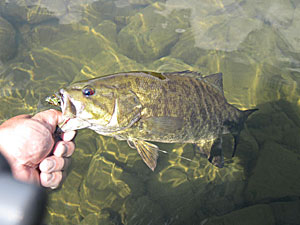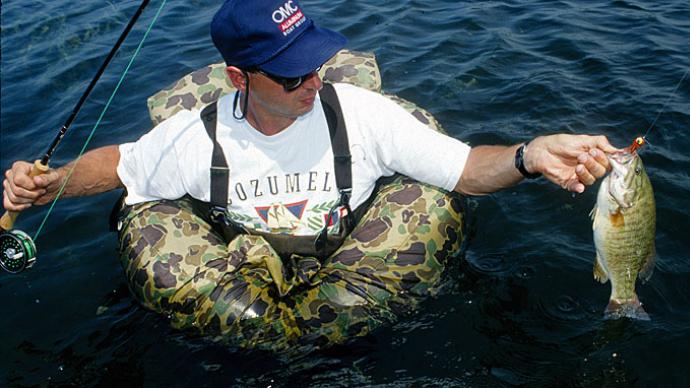
There was a hatch of fly-fishing interest when the movie “A River Runs Through It” was released in 1992. Brad Pitt plays one of two brothers who, among other things, cast flies for Montana river trout with their minister father. Like other fads popularized by Hollywood — such as fashions and sayings — this one has cooled, too. But that doesn’t mean there still aren’t anglers who are interested in learning to fly fish, especially for bass, said Brian Shumaker, a lifelong fly fisherman from central Pennsylvania. You might be among them. The anglers drawn to it today aren’t interested in mimicking a movie star.
Fly fishing isn’t just about catching fish for dedicated fly fishermen. It’s an experience and a skill that brings a sense of accomplishment. It adds excitement to fishing and a new way to appreciate it. “I think it’s the strike,” Shumaker said of why he loves fly fishing. “Especially if it’s real clear water, and you can see the take of the fly.”
Where to start
Shumaker’s life has always included fly fishing. He grew up near a river and spent hours exploring it. His father, who was an avid trout angler, introduced him to fly fishing. At one time his grandfather had access to a few farm ponds. Shumaker would tag along, casting popping flies for largemouth bass. For more than 20 years, he has operated Susquehanna Fishing Guides, which specializes in fly fishing for smallmouth bass.
Shumaker’s guide business is based in New Cumberland, Pa., on the banks of the Susquehanna River, which flows about 450 miles from near Cooperstown, N.Y., through Pennsylvania and Maryland, where it meets the Chesapeake Bay at Harve de Grace. He fishes the section near his home and the Juniata River, which joins the Susquehanna about 15 miles northwest of Harrisburg, Pa. Filled with shallow runs and riffles formed by limestone rocks, he runs the rivers in a jet boat or floats them in a Western-style drift boat, depending on conditions.
Smallmouth bass are Shumaker’s primary target, but muskies and walleyes also bite. So do carp, some up to 25 pounds. “You have to stalk the carp,” he said. “They are very skittish. It’s a lot like fishing for bonefish.” The smallmouth he catches aren’t quite as giant. Most are from 14 to 17 inches, with ones pushing 21 or 22 inches — about 4 pounds — mixed in regularly. His largest was just 24 inches, and he caught it in August when the river was low.
Conventional tackle — spinning and casting rods — are the hallmark of bass anglers. They are relatively easy to use, especially for beginners, and efficiently handle bass from presentation to landing. Learning to fly fish for bass won’t be much of a stretch if that gear feels comfortable in your hands. “If you’re a conventional angler, you are already ahead of the learning curve,” Shumaker said. “You know how to read the water.”

But before you can use a fly to catch a smallmouth like Shumaker’s biggest, you need the right gear and understand how it works. Here’s how he recommends you start fly fishing for bass. He also encourages newbies to visit their local fly shop. He said there’s no better place for detailed instructions tailored to local waters.
Fly rods and reels
Trout draw the most fly anglers. At the same time, some of those approaches will work when fly fishing for bass, the gear is different. Let’s start with the rods. Conventional rods are matched to a range of line and lure weights. Fly rods are specific to one or two-line weights. They range from 1 weight — the lightest — to 14 and heavier. Trout anglers typically use 4-, 5- or 6-weight rods, Shumaker says, and bass fishing demands 7- or 8-weight rods, such as those in Temple Fork Outfitters’ Mangrove or Clouser series. These weight fly rods are between 8- and 9 feet long. You’ll need a fly reel, too.
“You don’t need an expensive reel because for bass fishing, it’s going just to hold the line,” he said. Fish much larger than bass, such as tarpon or salmon, are fought from the reel, but you can land even the biggest bass by simply pinching the line with your casting hand and then stripping it in with your other. While some rods, such as those made by Sage, Winston and Orvis, sell for as much as $1,000, you’re better off, at least in the beginning, investing in the line.
Fly line
Fly line isn’t cheap. Good lines can cost $80 or more. Purchase the best fly line that you can afford because it will do most of the work. Its mass is what propels your casts, and it’s what you’ll use to manipulate your fly during the retrieve. You’ll need two types of line.
The first is a floating line, such as Cortland Precision Big Fly line for either a 7- or 8-weight rod. As its name implies, it lies on the surface. The other is an intermediate sinking line, such as Cortland Precision Ghost Tip for a 7- or 8-weight rod. It sinks about 12 to 18 inches every second, which will draw your fly down to deeper bass. Heavier lines are available for fishing even deeper, such as when water temperatures are at their lowest of the year. “We’ll still fish the fly rod when water temperatures are in the high 40s,” Shumaker said. He pulls that heavy line with short strips, which keep his streamer in the strike zone longer. You’ll need a monofilament leader with either line, which tapers from the fly line to the fly.
If you are starting with one fly rod and reel, buy two spools for the reel. That way you can easily switch between floating and sinking lines, depending on the conditions. When you’re ready to add a second setup, rig each rod with something different. Then you can cycle through them as conditions and situations change in front of you, much as you would with conventional tackle.
Casting
Once you have the rod and reel, you’ll need to cast it. “The hardest part for beginners is learning how to cast,” Shumaker said. And a lot of that has to do with the physics of fly casting: the weight of the line carries the fly out. In conventional tackle, it’s the weight of the lure that pulls the line from the reel.
Chances are the folks at your local fly shop offer casting classes or have a few minutes for some impromptu pointers in the parking lot. But if you have to go it alone, pack plenty of patience and these tips from Shumaker. First, keep your wrist locked, and use your forearm and shoulder to move the rod, like a windshield wiper, between 10 and 2 o’clock, if 12 is straight up. Keep the movement tight and crisp, pausing long enough on the back and forward casts for the line to straighten out. Point the tip at the intended target at the end your forward movement to increase casting accuracy.
Regardless of how you learn, casting practice is vital to your future enjoyment of fly fishing. And because you don’t need to attach a fly, any open space — land or water — is perfect for developing it. “Once you learn the basics, everyone develops their own style [of casting],” said Shumaker, who likes to angle his rod off to the side while casting.
Flies
There is a seemingly endless selection of flies, something anglers who have shopped for conventional lures will find familiar. Shumaker mostly chases smallmouth with 4- to 6-inch streamers — flies that mimic baitfish. The Clouser minnow, which uses lead eyes for weight, is one example. Others use lead wire wrapped around the hook or a head made from a brass cone for weight. The Murdich Minnow is another streamer, though it’s tied without weight, so it suspends when fished on a weighted line. Regardless of the fly, it’s controlled with the line. Unlike a tube jig, which is moved with the rod tip, flies are moved by stripping line. Longer strips move the fly faster; shorter strips add a darting action.
Selecting which color of fly to use is similar to choosing a conventional lure. In clear water, Shumaker “matches the hatch,” selecting flies that mimic prevalent prey. One of his favorite patterns is baby bass, which incorporates olive green, brown and white bucktail. But he also uses chartreuse-and-white streamers that elicit reaction strikes.

Shumaker said largemouth are suckers for flies, too. But instead of relying on steamers, catching largemouth more often involves floating flies. That’s not because largemouth are always looking up for a meal but because of where they live. A topwater approach is the best way to get a fly into the heavy weeds and other forms of cover they prefer.
Flies can out fish conventional lures in certain situations. They shine brightest when the rivers near Shumaker’s home run low and clear in the dog days of July and August. The quiet presentation and natural-looking flies don’t repel skittish smallmouth like time-tested tubes and spinnerbaits can under those conditions.
But flies are not always the best choice. In spring, when rivers are high, cold and stained, it’s almost impossible to get — and keep — a fly where bass are hiding. It’s then that he’ll reach for a spinning rod rigged with a tube stuffed with a heavy head.
You’ll find the flies you need at your local fly shop, but at some point you might be tempted to tie your own. It’s a natural step for an evolving fly angler, but it can quickly turn into a big one. “Everybody thinks it’s cheaper to tie your own,” Shumaker said. “Trust me. It’s more [money].” He has an entire room in his house dedicated to fly tying. It has come to resemble a small fly shop. But on winter days, when it’s 10 degrees and snowing outside, he finds warmth and inspiration there, tying flies for the upcoming season. “It sure makes winter go faster,” he said.
Hit the water
Fly and conventional anglers target the same spots. Pools, current seams and eddies are places to fish in rivers. On lakes, fish available cover and stretches of windblown bank. You won’t be able to drop your fly into ambush spots as you can pitching a jig, but make sure your retrieves bring your fly across these areas.
Wherever you make your first fly casts, Shumaker suggests you monitor your frustration level. Getting the hang of fly fishing might take some time. He recommends bringing a spinning rod along on your first few fly outings. If your casting isn’t coming together that day, switch to the spinning rod until you’re ready to try again. In time, you’ll work out the kinks, and the spinning rod will stay in the bottom of the boat longer. A bass or two along the way will help, too. “It’s a great sport,” Shumaker said. “I love it, and I probably fish it 85 percent of the time. But I still throw spinning tackle, too.”




